
Groundnuts Ring Spot Virus (GRSV)
Peanut ring spot virus
General
- Tospovirus transmitted by thrips in the circulating persistent mode.
- Detected for the first time in South Africa, but especially reported on the American continent (Argentina, Brazil, USA).
- The earlier its attacks, the greater its impact on crops.
- Being an emerging virus, the diversity of host plants for this bio-aggressor is still poorly understood. Mainly found on Solanaceae, this pathogen has also been referenced on the following crops: lettuces, peanuts, coriander and soybeans.
- Observed mainly in the open field, sometimes under shelter.
- Susceptible botanical family(s)
| Solanaceae | Composed |
- Production areas affected :
| Mayotte |
Detected in 2017 on Mayotte
- Organs attacked
| Leaves | Fruits | Stem |
Symptoms :
- Small chlorotic to necrotic leaf spots, presence of brown rings (figures 1 and 2-salad). The necrotic spots coalesce and lead to necrosis and drying out of the blade sector (figure 3 salad) or of entire leaves.
- Growth of plants strongly affected (figures 4 and 6 salad), these can wither and become partially or completely necrotic (figures 5 and 6-salad).
- Possible confusion : Symptoms of GRSV are similar to those of TSWV . Confusion is common and only a laboratory analysis can make the distinction.
- Signs : no visible signs, confirm the possible presence of thrips.
Biology
-
Conservation : unlike TSWV, GRSV persists on a very limited number of weeds, vegetable, aromatic or industrial cultivated species (tomato, eggplant, pepper, tobacco, lettuce, coriander), a single ornamental species (impatiens), and on certain food or industrial crops in hot zones (peanuts, soya). This virus, which is still little known, must be the subject of further research in order to determine the diversity of plant species capable of hosting it.
-
Transmission : by several species of thrips according to the persistent mode. Currently, 3 species of thrips have been recognized as vectors: Frankliniella occidentalis (Pergande), Frankliniella schultzei (Trybom) and Franklinella intosa (Trybom). In the case of Mayotte, it is strongly suspected that the transmission takes place via Caliothrips helinii (Hood). However, this remains to be officially determined. Only the larvae are susceptible to acquiring the virus. Also transmissible by seeds and vegetative reproductive organs in several plants.
Protection
- Use more or less resistant varieties (tomato, pepper).
- Protect nurseries and young plants in the field with veils (Agryl P17 type) or mesh fabrics (Filbio type), etc.
- Ensure the perfect sanitary quality of the plants.
- weed the surroundings of the nursery, and those of the plots in order to eliminate sources of viruses and/or vectors.
- Place blue sticky signs in shelters to monitor potential thrips infestation pressure.
- Avoid setting up a new culture near old cultures that may already be contaminated, or sensitive cultures.
- Control thrips populations ( biological control , insecticide protection ). Insecticide treatments can be essential to control thrips populations ( e-phy ), they slightly limit the incidence of GRSV.
- Mulching that reflects UV radiation limits thrips attacks on the crop.
- Quickly eliminate the first infected plants in the nursery or in the culture.
- Quickly eliminate plants at the end of cultivation.
- Carry out a crawl space of 3 to 4 weeks between crops.





